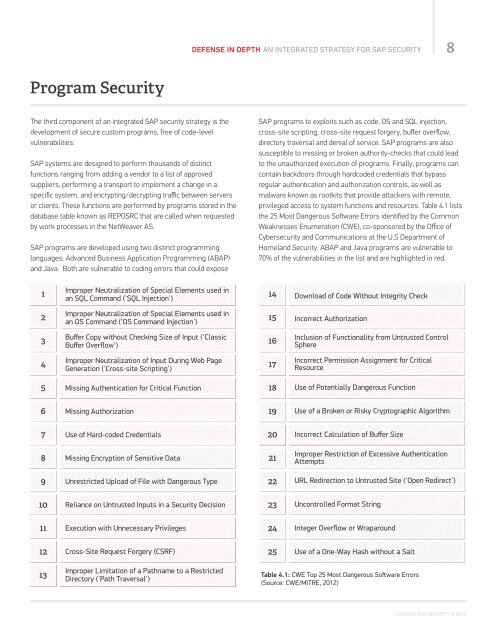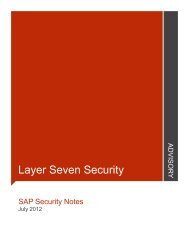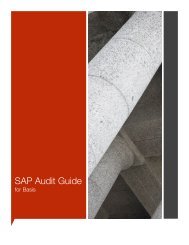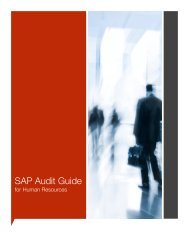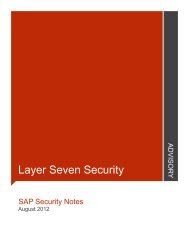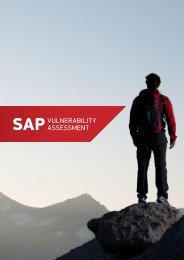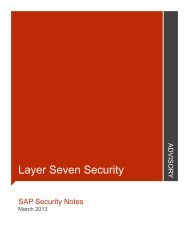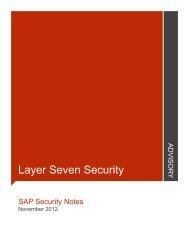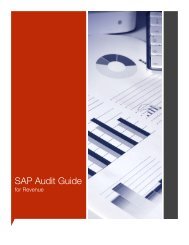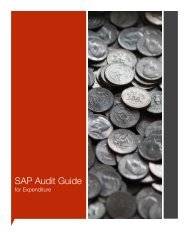Download - Layer Seven Security
Download - Layer Seven Security
Download - Layer Seven Security
You also want an ePaper? Increase the reach of your titles
YUMPU automatically turns print PDFs into web optimized ePapers that Google loves.
DEFENSE IN DEPTH AN INTEGRATED STRATEGY FOR SAP SECURITY 8<br />
Program <strong>Security</strong><br />
The third component of an integrated SAP security strategy is the<br />
development of secure custom programs, free of code-level<br />
vulnerabilities.<br />
SAP systems are designed to perform thousands of distinct<br />
functions ranging from adding a vendor to a list of approved<br />
suppliers, performing a transport to implement a change in a<br />
specific system, and encrypting/decrypting traffic between servers<br />
or clients. These functions are performed by programs stored in the<br />
database table known as REPOSRC that are called when requested<br />
by work processes in the NetWeaver AS.<br />
SAP programs are developed using two distinct programming<br />
languages: Advanced Business Application Programming (ABAP)<br />
and Java. Both are vulnerable to coding errors that could expose<br />
SAP programs to exploits such as code, OS and SQL injection,<br />
cross-site scripting, cross-site request forgery, buffer overflow,<br />
directory traversal and denial of service. SAP programs are also<br />
susceptible to missing or broken authority-checks that could lead<br />
to the unauthorized execution of programs. Finally, programs can<br />
contain backdoors through hardcoded credentials that bypass<br />
regular authentication and authorization controls, as well as<br />
malware known as rootkits that provide attackers with remote,<br />
privileged access to system functions and resources. Table 4.1 lists<br />
the 25 Most Dangerous Soſtware Errors identified by the Common<br />
Weaknesses Enumeration (CWE), co-sponsored by the Office of<br />
Cybersecurity and Communications at the U.S Department of<br />
Homeland <strong>Security</strong>. ABAP and Java programs are vulnerable to<br />
70% of the vulnerabilities in the list and are highlighted in red.<br />
1<br />
Improper Neutralization of Special Elements used in<br />
an SQL Command ('SQL Injection')<br />
14<br />
<strong>Download</strong> of Code Without Integrity Check<br />
2<br />
Improper Neutralization of Special Elements used in<br />
an OS Command ('OS Command Injection')<br />
15<br />
Incorrect Authorization<br />
3<br />
Buffer Copy without Checking Size of Input ('Classic<br />
Buffer Overflow')<br />
16<br />
Inclusion of Functionality from Untrusted Control<br />
Sphere<br />
4<br />
Improper Neutralization of Input During Web Page<br />
Generation ('Cross-site Scripting')<br />
17<br />
Incorrect Permission Assignment for Critical<br />
Resource<br />
5<br />
Missing Authentication for Critical Function<br />
18<br />
Use of Potentially Dangerous Function<br />
6<br />
Missing Authorization<br />
19<br />
Use of a Broken or Risky Cryptographic Algorithm<br />
7<br />
Use of Hard-coded Credentials<br />
20<br />
Incorrect Calculation of Buffer Size<br />
8<br />
Missing Encryption of Sensitive Data<br />
21<br />
Improper Restriction of Excessive Authentication<br />
Attempts<br />
9<br />
Unrestricted Upload of File with Dangerous Type<br />
22<br />
URL Redirection to Untrusted Site ('Open Redirect')<br />
10<br />
Reliance on Untrusted Inputs in a <strong>Security</strong> Decision<br />
23<br />
Uncontrolled Format String<br />
11<br />
Execution with Unnecessary Privileges<br />
24<br />
Integer Overflow or Wraparound<br />
12<br />
Cross-Site Request Forgery (CSRF)<br />
25<br />
Use of a One-Way Hash without a Salt<br />
13<br />
Improper Limitation of a Pathname to a Restricted<br />
Directory ('Path Traversal')<br />
Table 4.1: CWE Top 25 Most Dangerous Soſtware Errors<br />
(Source: CWE/MITRE, 2012)<br />
LAYER SEVEN SECURITY © 2013


